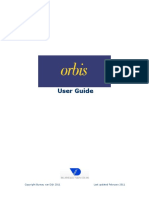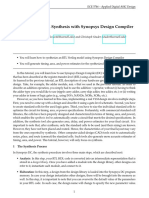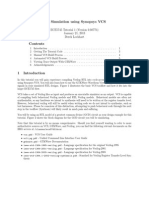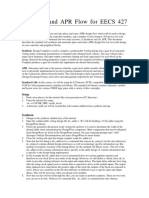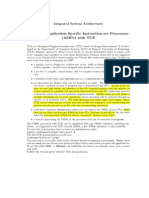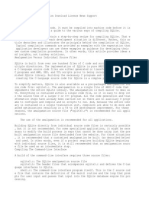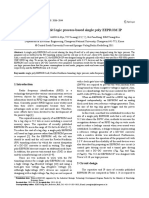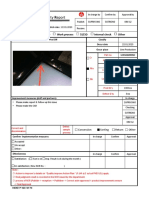Tut5 DC
Tut5 DC
Uploaded by
Phuc HoangCopyright:
Available Formats
Tut5 DC
Tut5 DC
Uploaded by
Phuc HoangOriginal Description:
Original Title
Copyright
Available Formats
Share this document
Did you find this document useful?
Is this content inappropriate?
Copyright:
Available Formats
Tut5 DC
Tut5 DC
Uploaded by
Phuc HoangCopyright:
Available Formats
RTL-to-Gates Synthesis using Synopsys Design Compiler
CS250 Tutorial 5 (Version 091210b) September 12, 2010 Yunsup Lee
In this tutorial you will gain experience using Synopsys Design Compiler (DC) to perform hardware synthesis. A synthesis tool takes an RTL hardware description and a standard cell library as input and produces a gate-level netlist as output. The resulting gate-level netlist is a completely structural description with standard cells only at the leaves of the design. Internally, a synthesis tool performs many steps including high-level RTL optimizations, RTL to unoptimized boolean logic, technology independent optimizations, and nally technology mapping to the available standard cells. Good RTL designers will familiarize themselves with the target standard cell library so that they can develop an intuition on how their RTL will be synthesized into gates. In this tutorial you will use Synopsys Design Compiler to elaborate RTL, set optimization constraints, synthesize to gates, and prepare various area and timing reports. You will also learn how to read the various DC text reports and how to use the graphical Synopsys Design Vision tool to visualize the synthesized design. Synopsys provides a library called Design Ware which includes highly optimized RTL for arithmetic building blocks. DC can automatically determine when to use Design Ware components and it can then eciently synthesize these components into gate-level implementations. In this tutorial you will learn more about what Design Ware components are available and how to best encourage DC to use them. The following documentation is located in the course locker (~cs250/manuals) and provides additional information about Design Compiler, Design Vision, the Design Ware libraries, and the Synopsys 90nm Standard Cell Library. dc-user-guide.pdf - Design Compiler User Guide dc-quick-reference.pdf - Design Compiler Quick Reference dc-user-guide-cli.pdf - Design Compiler Command-Line Interface Guide dc-user-guide-lp.pdf - Synopsys Low-Power Flow User Guide dc-user-guide-verilog.pdf - HDL Compiler for Verilog User Guide dc-user-guide-sysverilog.pdf - HDL Compiler for SystemVerilog User Guide dc-user-guide-tcl.pdf - Using Tcl With Synopsys Tools dc-user-guide-tco.pdf - Synopsys Timing Constraints and Optimization User Guide dc-reference-manual-opt.pdf - Design Compiler Optimization Reference Manual dc-reference-manual-rt.pdf - Design Compiler Register Retiming Reference Manual dc-application-note-sdc.pdf - Synopsys Design Constraints Format Application Note dc dv-user-guide.pdf - Design Vision User Guide dc dv-tutorial.pdf - Design Compiler Tutorial Using Design Vision designware-intro.pdf - DesignWare Building Block IP Documentation Overview designware-user-guide.pdf - DesignWare Building Block IP designware-quick-reference.pdf - DesignWare Building Block IP Quick Reference designware-datasheets - Directory containing datasheets on each DW component synopsys-90nm-databook-stdcells.pdf - Digital Standard Cell Library Databook
CS250 Tutorial 5 (Version 091210b), Fall 2010
Getting started
You can follow along through the tutorial yourself by typing in the commands marked with a % symbol at the shell prompt. To cut and paste commands from this tutorial into your bash shell (and make sure bash ignores the % character) just use an alias to undene the % character like this: % alias %="" All of the CS250 tutorials should be ran on an EECS Instructional machine. Please see the course website for more information on the computing resources available for CS250 students. Once you have logged into an EECS Instructional you will need to setup the CS250 toolow with the following commands. % source ~cs250/tools/cs250.bashrc For this tutorial you will be using an unpipelined RISC-V v1 processor as your example RTL design. Figure 1 shows the system diagram which is implemented by the example code.
PC
pc+4 branch
Cmp +4
eq?
ir[24:20] tohost_en
pc_sel
ir[19:15]
Reg File
rd1
Add
val
wb_sel
op0
Instruction Mem
ir[24:20]
rd0
ir[11:0]
>>1
op1
Sign Extend
Reg File
Decoder
Control Signals
rdata addr wdata
Data Mem
rw val
tohost
rf_wen testrig_tohost
Figure 1: Block diagram for Unpipelined RISC-V v1 Processor
You should create a working directory and copy les from the course locker using the following commands. % % % % mkdir tut5 cd tut5 TUTROOT=$PWD cp -R ~cs250/examples/v-riscv-v1-1stage/* $TUTROOT
CS250 Tutorial 5 (Version 091210b), Fall 2010
Before starting, take a look at the subdirectories in the project directory. When pushing designs through the physical toolow you will often refer to the core. The core module contains everything which will be on-chip, while blocks outside the core are assume to be o-chip. For this tutorial you are assuming that the processor and a combinational memory are located within the core. A combinational memory means that the read address is specied at the beginning of the cycle, and the read data returns during the same cycle. Building large combinational memories is relatively inecient. It is much more common to use synchronous memories. A synchronous memory means that the read address is specied at the end of a cycle, and the read data returns during the next cycle. From Figure 1 it should be clear that the unpipelined RISC-V v1 processor requires combinational memories (or else it would turn into a four stage pipeline). For this tutorial you will not be using a real combinational memory, but instead this combinational memory will be simulated inside the test harness. Therefore, riscvProc will be the top module that you will be pushing through the toolow in this tutorial. In later tutorials, you will start using synchronous on-chip SRAMs, and this case riscvCore will be the top module you will be pushing through the toolow. Figure 2 shows the relationship among these hierarchies in more detail. The grey part depicts the test harness.
riscvTestHarness riscvCore
riscvProc
Instruction Memory
Data Memory
comb0_delay imem_access_delay
dmem_access_delay comb1_delay
clock period
Figure 2: Setup for the unpipelined RISC-V v1 Core
In order to synthesize the processor correctly with the two combinational memory, you need to specify the input and output delays carefully. The input and output delays are marked on one clock period in gure 2. The output delay of the instruction request signals from the processor (input signals to the instruction memory) should be specied as clock period - comb0 delay. The input delay
CS250 Tutorial 5 (Version 091210b), Fall 2010
of the instruction response signals to the processor (output signals from the instruction memory) can be described as comb0 delay + imem access delay. The output delay of the data request signals from the processor (input signals to the data memory) should be specied as dmem access delay + comb1 delay. The input delay of the data response signals to the processor (output signals from the data memory) can be described as clock period - comb1 delay. These constants are specied in build/Makefrag. The build directory will also contain all generated content including simulators, synthesized gatelevel Verilog, and nal layout. In this course you will always try to keep generated content separate from your source RTL. This keeps your project directories well organized, and helps prevent you from unintentionally modifying your source RTL. There are subdirectories in the build directory for each major step in the CS250 toolow. These subdirectories contain scripts and conguration les for running the tools required for that step in the toolow. For this tutorial you will work exclusively in the dc-syn.
Synthesizing the Processor
You will begin by running several DC commands manually before learning how you can automate the tool with scripts. DC can generate a large number of output les, so you will be running DC within a build directory beneath dc-syn. Use the following commands to create a build directory for DC and to start the DC shell. To cut and past commands from this lab into your Design Compiler shell and make sure Design Compiler ignores the dc shell-topo> string, we will use an alias to undene the dc shell-topo> string. % cd $TUTROOT/build/dc-syn % mkdir manual % cd manual % dc_shell-xg-t -64bit -topographical_mode ... Initializing... dc_shell-topo> alias "dc_shell-topo>" "" You should be left at the DC shell prompt from which you can can execute various commands to load in your design, specify constraints, synthesize your design, print reports, etc. You can get more information about a specic command by entering man <command> at the dc shell prompt. You will now execute some commands to setup your environment. dc_shell-topo> set ucb_vlsi_home [getenv UCB_VLSI_HOME] dc_shell-topo> set stdcells_home \ $ucb_vlsi_home/stdcells/synopsys-90nm/default dc_shell-topo> set_app_var search_path \ "$stdcells_home/db $ucb_vlsi_home/install/vclib ../../../src" dc_shell-topo> set_app_var target_library "cells.db" dc_shell-topo> set_app_var synthetic_library "dw_foundation.sldb" dc_shell-topo> set_app_var link_library "* $target_library $synthetic_library" dc_shell-topo> set_app_var alib_library_analysis_path "$stdcells_home/alib" dc_shell-topo> set_app_var mw_logic1_net "VDD" dc_shell-topo> set_app_var mw_logic0_net "VSS"
CS250 Tutorial 5 (Version 091210b), Fall 2010 dc_shell-topo> create_mw_lib -technology $stdcells_home/techfile/techfile.tf \ -mw_reference_library $stdcells_home/mw/cells.mw "riscvProc_LIB" dc_shell-topo> open_mw_lib "riscvProc_LIB" dc_shell-topo> check_library dc_shell-topo> set_tlu_plus_file \ -max_tluplus $stdcells_home/tluplus/max.tluplus \ -min_tluplus $stdcells_home/tluplus/min.tluplus \ -tech2itf_map $stdcells_home/techfile/tech2itf.map dc_shell-topo> check_tlu_plus_files dc_shell-topo> define_design_lib WORK -path "./work"
These commands point to your Verilog source directory, create a Synopsys work directory, and point to the standard libraries you will be using for this class. The DB le contains timing/area information for each standard cell, and the Milkyway library contains wireload models. DC will use this information to try and optimize the synthesis process. You can now load your Verilog design into Design Compiler with the analyze, elaborate, and link commands. Executing these commands will result in a great deal of log output as the tool elaborates some Verilog constructs and starts to infer some high-level components. Try executing the commands as follows. dc_shell-topo> analyze -format verilog \ "defCommon.vh riscvInst.vh riscvConst.vh \ riscvProcCtrl.v riscvProcDpathRegfile.v riscvProcDpath.v \ riscvProc.v" dc_shell-topo> elaborate "riscvProc" dc_shell-topo> link Take a closer look at the output during elaboration. DC will report all state inferences. This is a good way to verify that latches and ip-ops are not being accidentally inferred. You should be able to check that the only inferred state elements are the PC, the tohost register, a one-bit reset register, and the register le. DC will also note information about inferred muxes. Figure 3 shows a fragment from the elaboration output text. From this output you can see that DC is inferring 32-bit ip-ops for the register le and two 32 input 32-bit muxes for the register le read ports. See the HDL Compiler for Verilog User Guide (dc-user-guide-verilog.pdf) for more information on the output from the elaborate command and more generally how DC infers combinational and sequential hardware elements. After reading your design into DC you can use the check design command to check that the design is consistent. A consistent design is one which does not contain any errors such as unconnected ports, constant-valued ports, cells with no input or output pins, mismatches between a cell and its reference, multiple driver nets, connection class violations, or recursive hierarchy denitions. You will not be able to synthesize your design until you eliminate any errors. Many of these warning are obviously not an issue, but it is still useful to skim through this output. dc_shell-topo> check_design Before you can synthesize your design, you must specify some constraints; most importantly you must tell the tool your target clock period. The following commands tell the tool that the pin named clk is the clock and that your desired clock period is 2.5 nanoseconds. You need to set the clock period constraint carefully. If the period is unrealistically small, then the tools will spend
CS250 Tutorial 5 (Version 091210b), Fall 2010
in routine riscvProcDpathRegfile line 26 in file ../../../src/riscvProcDpathRegfile.v. =============================================================================== | Register Name | Type | Width | Bus | MB | AR | AS | SR | SS | ST | =============================================================================== | registers_reg | Flip-flop | 32 | Y | N | N | N | N | N | N | ... | registers_reg | Flip-flop | 32 | Y | N | N | N | N | N | N | =============================================================================== Statistics for MUX_OPs =================================================================== | block name/line | Inputs | Outputs | # sel inputs | MB | =================================================================== | riscvProcDpathRegfile/22 | 32 | 32 | 5 | N | | riscvProcDpathRegfile/23 | 32 | 32 | 5 | N | ===================================================================
Figure 3: Output from the Design Compiler elaborate command forever trying to meet timing and ultimately fail. If the period is too large, then the tools will have no trouble but you will get a very conservative implementation. You also need to specify the input and output delays discussed in gure 2. For more information about constraints consult the Synopsys Timing Constraints and Optimization User Guide (dc-user-guide-tco.pdf). dc_shell-topo> dc_shell-topo> dc_shell-topo> dc_shell-topo> dc_shell-topo> dc_shell-topo> dc_shell-topo> dc_shell-topo> dc_shell-topo> create_clock clk -name ideal_clock1 -period 2.5 set_output_delay -clock ideal_clock1 2.3 imemreq_bits_addr set_output_delay -clock ideal_clock1 2.3 imemreq_val set_input_delay -clock ideal_clock1 0.6 imemresp_bits_data set_output_delay -clock ideal_clock1 0.65 dmemreq_bits_rw set_output_delay -clock ideal_clock1 0.65 dmemreq_bits_addr set_output_delay -clock ideal_clock1 0.65 dmemreq_bits_data set_output_delay -clock ideal_clock1 0.65 dmemreq_val set_input_delay -clock ideal_clock1 2.25 dmemresp_bits_data
Now you are ready to use the compile ultra command to actually synthesize your design into a gate-level netlist. -gate clock enables clock gating. -no autoungroup is specied in order to preserve the hierarchy during synthesis or disable inter-module optimizations. With no options given, compile ultra command optimizes across module boundaries. For more information on the compile ultra command consult the Design Compiler User Guide (dc-user-guide.pdf) or use man compile ultra at the DC shell prompt. Run the following command and take a look at the output. DC will attempt to synthesize your design while still meeting the constraints. DC considers two types of constraints: user specied constraints and design rule constraints. User specied constraints can be used to constrain the clock period (as you saw with the create clock command) but they can also be used to constrain the arrival of certain input signals, the drive strength of the input signals, and the capacitive load on the output signals. Design rule constraints are xed constraints which are specied by the standard cell library. For example, there are restrictions on the loads specic gates can drive and on the transition times of certain pins. For more information consult Synopsys Design Constraints Format Application Note (dc-application-note-sdc.pdf).
CS250 Tutorial 5 (Version 091210b), Fall 2010 dc_shell-topo> compile_ultra -gate_clock -no_autoungroup
The compile command will report how the design is being optimized. You should see DC performing technology mapping, delay optimization, and area reduction. Figure 4 shows a fragment from the compile output. Each line is an optimization pass. The area column is in units specic to the standard cell library which is um2 , but for now you should just use the area numbers as a relative metric. The worst negative slack column shows how much room there is between the critical path in your design and the clock constraint. Larger negative slack values are worse since this means that your design is missing the desired clock frequency by a greater amount. Total negative slack is the sum of all negative slack across all endpoints in the design - if this is a large negative number it indicates that not only is the design not making timing, but it is possible that many paths are too slow. If the total negative slack is a small negative number, then this indicates that only a few paths are too slow. The design rule cost is a indication of how many cells violate one of the standard cell library design rules constraints. Figure 4 shows that on the rst iteration, the tool makes timing but at a high area cost, so on the second iteration it optimizes area but this causes the design to no longer meet timing. The tool continues to optimize until it meets the constraints.
... ELAPSED WORST NEG TOTAL NEG DESIGN LEAKAGE TIME AREA SLACK SLACK RULE COST ENDPOINT POWER --------- --------- --------- --------- --------- ------------- --------0:00:25 56092.3 0.68 193.7 0.0 308556192.0000 Beginning Delay Optimization ---------------------------0:00:28 51442.8 0.28 0:00:28 51589.3 0.23 0:00:28 51589.3 0.23 0:00:33 52530.3 0.12 0:00:33 52530.3 0.12 0:00:35 54100.7 0.00 0:00:35 54100.7 0.00 0:00:35 54100.7 0.00 ...
5.4 4.5 4.5 2.1 2.1 0.0 0.0 0.0
0.0 0.0 0.0 0.0 0.0 0.0 0.0 0.0
274241280.0000 275486656.0000 275486656.0000 281122144.0000 281122144.0000 295563680.0000 295563680.0000 295563680.0000
Figure 4: Output from the Design Compiler compile ultra command You can now use various commands to examine timing paths, display reports, and further optimize your design. Entering in these commands by hand can be tedious and error prone, plus doing so makes it dicult to reproduce a result. Thus you will mostly use TCL scripts to control the tool. Even so, using the shell directly is useful for nding out more information about a specic command or playing with various options. Before continuing, exit the DC shell and delete your build directory with the following commands. dc_shell-topo> exit % cd $TUTROOT/build/dc-syn % rm -rf manual
CS250 Tutorial 5 (Version 091210b), Fall 2010
Automating Synthesis with TCL Scripts and Makeles
In this section you will examine how to use various TCL scripts and makeles to automate the synthesis process. There are a couple les you should take a close look in the build directory. Makefrag - Makele fragment le which contains clock period dc-syn/Makefile - Makele for driving synthesis with the TCL scripts dc-syn/rm dc scripts/dc.tcl - Primary TCL script which contains the DC commands dc-syn/rm dc scripts/find regs.tcl - TCL script which nds all reigsters dc-syn/rm setup/common setup.tcl - TCL fragment for various common variables dc-syn/rm setup/dc setup.tcl - TCL fragment for various library variables dc-syn/rm setup/dc setup filenames.tcl - TCL fragment for various lename variables dc-syn/constraints.tcl - User specied constraints
First take a look at the Makefrag le. This le contains the desired clock period. Notice that it uses a shorter clock period (90% of the desired clock period) for synthesis in order to leave some slack for place and route. Now open up the dc setup.tcl script. You will see that it sets up several library variables, creates the search path, and instructs DC to use a work directory. The rst line of the dc setup.tcl script loads the make generated vars.tcl script. This script is generated by the makele and it contains variables which are dened by the makele and used by the TCL scripts. You will take a closer look at it in a moment. Now examine the dc.tcl script. You will see many familiar commands which we executed by hand in the previous section. You will also see some new commands. Take a closer look at the bottom of this TCL script where we write out several text reports. Remember that you can get more information on any command by using man <command> at the DC shell prompt. The constraints.tcl le contains various user specied constraints. You specify that DC should assume that minimum sized inverters are driving the inputs to the design and that the outputs must drive 4 fF of capacitance. Now that you are more familiar with the various TCL scripts, you will see how to use the makele to drive synthesis. Look inside the makele and identify where the Verilog sources and the C sources are dened. Notice that the test harness is not included. You should only list those Verilog les which are part of the processor; do not included non-synthesizable test harnesses modules. Also notice that we must identify the toplevel Verilog module in the design, toplevel instance, and nally the test harness module. The build rules in the makele will create new build directories, copy the TCL scripts into these build directories, and then run DC. Use the following make target to create a new build directory. % cd $TUTROOT/build/dc-syn % make new-build-dir
You should now see a new build directory named build-<date> where <date> represents the time and date. The current-dc symlink always points to the most recent build directory. If you look inside the build directory, you will see the common setup.tcl, dc setup.tcl, dc setup filenames.tcl, dc.tcl, find regs.tcl and constraints.tcl scripts but you will also see an additional make generated vars.tcl script. Various variables inside make generated vars.tcl are used to specify the search path, which Verilog les to read in, which modules should be marked dont touch, the toplevel Verilog name, etc. After using make new-build-dir you can cd into the current-dc directory, start the DC shell, and run DC commands by hand. For example, the following sequence will perform the same steps as in the previous section.
CS250 Tutorial 5 (Version 091210b), Fall 2010 % cd $TUTROOT/build/dc-syn % cd current-dc % dc_shell-xg-t -64bit -topographical_mode dc_shell-topo> alias "dc_shell-topo>" "" dc_shell-topo> source dc_setup.tcl dc_shell-topo> define_design_lib WORK -path ./work dc_shell-topo> analyze -format verilog ${RTL_SOURCE_FILES} dc_shell-topo> elaborate ${DESIGN_NAME} dc_shell-topo> link dc_shell-topo> source constraints.tcl dc_shell-topo> compile_ultra -gate_clock -no_autoungroup dc_shell-topo> exit
The new-build-dir make target is useful when you want to conveniently run through some DC commands by hand to try them out. To completely automate your synthesis you can use the dc make target (which is also the default make target). For example, the following commands will automatically synthesize the design and save several text reports to the build directory. % cd $TUTROOT/build/dc-syn % make dc You should see DC compiler start and then execute the commands located in the dc.tcl script. Once synthesis is nished try running make dc again. The makele will detect that nothing has changed (i.e. the Verilog source les and DC scripts are the same) and so it does nothing. Edit Makefrag and change the clock period constraint to 10 ns. Now use make dc to resynthesize the design. Since you changed the clock period, make will correctly run DC again. Take a look at the current contents of dc-syn. % cd $TUTROOT/build/dc-syn % ls -l total 32 -rw-r--r-- 1 yunsup grad 5003 drwxr-xr-x 7 yunsup grad 4096 drwxr-xr-x 7 yunsup grad 4096 -rw-r--r-- 1 yunsup grad 1712 lrwxrwxrwx 1 yunsup grad 25 drwxr-xr-x 2 yunsup grad 4096 drwxr-xr-x 2 yunsup grad 4096 drwxr-xr-x 2 yunsup grad 4096
Sep Sep Sep Sep Sep Sep Sep Sep
12 12 12 12 12 12 12 12
10:52 11:12 11:14 10:52 11:13 10:52 10:52 10:52
Makefile build-dc-2010-09-12_11-11 build-dc-2010-09-12_11-13 constraints.tcl current-dc -> build-dc-2010-09-12_11-13 rm_dc_scripts rm_notes rm_setup
Notice that the makele does not overwrite build directories. It always creates new build directories. This makes it easy to change your synthesis scripts or source Verilog, resynthesize your design, and compare your results to previous designs. You can use symlinks to keep track of what various build directories correspond to. For example, the following commands label the build directory which corresponds to a 2.5 ns clock period constraint and the build directory which corresponds to a 10 ns clock period constraint. % cd $TUTROOT/build/dc-syn % ln -s build-dc-2010-09-12_11-11 build-2.5ns % ln -s build-dc-2010-09-12_11-13 build-10ns
CS250 Tutorial 5 (Version 091210b), Fall 2010
10
Every so often you should delete old build directories to save space. The make clean command will delete all build directories so use it carefully. Sometimes you want to really force the makele to resynthesize the design but for some reason it may not work properly. To force a resynthesis without doing a make clean simply remove the current symlink. For example, the following commands will force a resynthesis without actually changing any of the source TCL scripts or Verilog. % cd $TUTROOT/build/dc-syn % rm -f current-dc % make dc
Interpreting the Synthesized Gate-Level Netlist and Text Reports
In this section you will examine some of the output which our dc.tcl script generates. You will initially focus on the contents of the build-2.5ns build directory. The primary output from the synthesis scripts is the synthesized gate-level netlist which is contained in results/riscvProc.mapped.v. Take a look at the gate-level netlist for the 2.5 ns clock constraint. Notice that the RTL module hierarchy is preserved in the gate-level netlist since you did not atten any part of your design. Find the four two-input multiplexers in the gate-level netlist by searching for riscvProcDpathMux. Although the same two-input mux was instantiated four times in the design (the PC mux, the Adder operand muxes, and the writeback mux), DC has optimized each multiplexer dierently. Figure 5 shows the gate-level netlist for the synthesized multiplexers. From the gate-level netlist you can determine that the tool synthesized dierent types of muxes. The PC mux, operand 1 mux, and the write back mux used MUX21X1 standard cells with some buers.Use the databook for the Synopsys 90nm Standard Cell Library (synopsys-90nm-databook-stdcells.pdf) to determine the function of the MUX21X1 standard cell. You should discover that this is a 2 input 1-bit mux cell. Notice that the pc mux used 32 MUX21X1 cells. In constrast, op 0 mux used a lot of random standard cells. Looking back into gure 1, you can notice that one of the input operand comes from register le. The tool has gured out that op 0 mux is on the critical path, and selected a dierent architecture (a combinational reduction tree) to implement a mux. All input operands of op 1 mux comes directly from the instruction, and therefore it changed less MUX21X1 standard cells into a reduction tree. In addition to the actual synthesized gate-level netlist, the dc.tcl also generates several reports. Reports usually have the rpt lename sux. The following is a list of the synthesis reports. reports/*.mapped.area.rpt - Area information for each module instance reports/*.mapped.clock gating.rpt - Clock gating information reports/*.mapped.power.rpt - Power information for each module instance reports/*.mapped.qor.rpt - QoR (Quality of Result) information and statistics reports/*.mapped.reference.rpt - Information on references reports/*.mapped.resources.rpt - Information on Design Ware components reports/*.mapped.timing.rpt - Contains critical timing paths log/dc.log - Log le of all output during DC run
CS250 Tutorial 5 (Version 091210b), Fall 2010
11
module riscvProcDpathMux_0 ( sel, in0, in1, out ); // ... MUX21X1 U10 ( .IN1(in0[15]), .IN2(in1[15]), .S(n3), MUX21X1 U11 ( .IN1(in0[16]), .IN2(in1[16]), .S(n3), MUX21X1 U12 ( .IN1(in0[17]), .IN2(in1[17]), .S(n3), MUX21X1 U13 ( .IN1(in0[18]), .IN2(in1[18]), .S(n3), MUX21X1 U14 ( .IN1(in0[19]), .IN2(in1[19]), .S(n3), MUX21X1 U15 ( .IN1(in0[20]), .IN2(in1[20]), .S(n3), ... endmodule
pc mux .Q(out[15]) .Q(out[16]) .Q(out[17]) .Q(out[18]) .Q(out[19]) .Q(out[20]) ); ); ); ); ); );
module riscvProcDpathMux_3 ( sel, in0, in1, out ); // op0 mux ... NAND2X2 U2 ( .IN1(n7), .IN2(n6), .QN(out[2]) ); NAND2X2 U19 ( .IN1(in1[9]), .IN2(sel), .QN(n10) ); NAND2X2 U24 ( .IN1(n13), .IN2(n12), .QN(out[11]) ); NAND2X2 U28 ( .IN1(n16), .IN2(n15), .QN(out[29]) ); NAND2X2 U32 ( .IN1(n19), .IN2(n18), .QN(out[28]) ); NAND2X2 U36 ( .IN1(n22), .IN2(n21), .QN(out[7]) ); NAND2X2 U40 ( .IN1(n25), .IN2(n24), .QN(out[25]) ); NAND2X2 U52 ( .IN1(n34), .IN2(n33), .QN(out[14]) ); NAND2X2 U58 ( .IN1(n57), .IN2(n56), .QN(out[16]) ); ... endmodule module riscvProcDpathMux_2 ( sel, in0, in1, out ); // op1 mux ... MUX21X1 U14 ( .IN1(in0[1]), .IN2(in0[0]), .S(sel), .Q(out[1]) ); MUX21X1 U15 ( .IN1(in0[4]), .IN2(in0[3]), .S(sel), .Q(out[4]) ); MUX21X1 U16 ( .IN1(in0[5]), .IN2(in0[4]), .S(sel), .Q(out[5]) ); MUX21X1 U17 ( .IN1(in0[6]), .IN2(in0[5]), .S(sel), .Q(out[6]) ); MUX21X1 U18 ( .IN1(in0[7]), .IN2(in0[6]), .S(sel), .Q(out[7]) ); MUX21X1 U19 ( .IN1(in1[10]), .IN2(in0[8]), .S(sel), .Q(out[9]) ); MUX21X1 U20 ( .IN1(in0[10]), .IN2(in1[10]), .S(sel), .Q(out[10]) ); MUX21X1 U21 ( .IN1(in0[11]), .IN2(in0[10]), .S(sel), .Q(out[11]) ); ... endmodule module riscvProcDpathMux_1 ( sel, in0, in1, out ); // wb mux ... MUX21X2 U37 ( .IN1(in0[10]), .IN2(in1[10]), .S(n35), .Q(out[10]) MUX21X2 U51 ( .IN1(in0[24]), .IN2(in1[24]), .S(n34), .Q(out[24]) MUX21X2 U50 ( .IN1(in0[23]), .IN2(in1[23]), .S(n34), .Q(out[23]) MUX21X2 U58 ( .IN1(in0[31]), .IN2(in1[31]), .S(n33), .Q(out[31]) MUX21X2 U55 ( .IN1(in0[28]), .IN2(in1[28]), .S(n33), .Q(out[28]) MUX21X2 U54 ( .IN1(in0[27]), .IN2(in1[27]), .S(n34), .Q(out[27]) MUX21X2 U52 ( .IN1(in0[25]), .IN2(in1[25]), .S(n34), .Q(out[25]) ... endmodule
); ); ); ); ); ); );
Figure 5: Gate-Level Netlist for Two Synthesized 32 Input 32-bit Muxes
CS250 Tutorial 5 (Version 091210b), Fall 2010
12
In this section you will discuss the area.rpt, timing.rpt, and the reference.rpt reports. The next section will discuss the resources.rpt report. The area.rpt report contains area information for each module in the design. Figure 6 shows a fragment from area.rpt for the RISCV v1 unpipelined processor. You can use the reference.rpt report (Figure 7 to gain insight into how various modules are being implemented. For example, you can use the reference report in a similar fashion as the results/riscvProc.mapped.v gate-level netlist to see that the riscvProcDpathMux 2 (op 1 mux) module includes only 8 mux cell.
Global cell area Local cell area ------------------- -----------------------------Hierarchical cell Absolute Percent CombiNoncombiBlack Total Total national national boxes -------------------------------- ---------- ------- ---------- ---------- -----riscvProc 53125.7656 100.0 32.2560 49.7664 0.0000 ctrl 259.8913 0.5 259.8913 0.0000 0.0000 dpath 52783.8516 99.4 5336.9897 1045.0942 0.0000 dpath/add_in0_mux 970.4451 1.8 970.4451 0.0000 0.0000 dpath/add_in1_mux 145.6128 0.3 145.6128 0.0000 0.0000 dpath/clk_gate_tohost_reg_reg 37.7856 0.1 12.9024 24.8832 0.0000 dpath/pc_mux 364.9537 0.7 364.9537 0.0000 0.0000 dpath/rfile 44453.7031 83.7 18652.0801 24683.9023 0.0000 dpath/rfile/clk_gate_registers_reg_10_ 35.9424 0.1 13.8240 22.1184 0.0000 ... dpath/rfile/clk_gate_registers_reg_9_ 35.9424 0.1 13.8240 22.1184 0.0000 dpath/wdata_mux 429.4657 0.8 429.4657 0.0000 0.0000 -------------------------------- ---------- ------- ---------- ---------- -----Total 26633.1465 26493.0254 0.0000
Figure 6: Fragment from riscvProc.mapped.area.rpt
**************************************** Design: riscvProcDpathMux_2 **************************************** Reference Library Unit Area Count Total Area Attributes ----------------------------------------------------------------------------AND2X1 saed90nm_typ 7.372800 1 7.372800 INVX0 saed90nm_typ 5.529600 2 11.059200 INVX2 saed90nm_typ 6.451200 1 6.451200 MUX21X1 saed90nm_typ 11.059200 8 88.473602 NAND2X0 saed90nm_typ 5.529600 7 38.707201 NAND2X1 saed90nm_typ 5.529600 2 11.059200 ----------------------------------------------------------------------------Total 6 references 163.123204
Figure 7: Fragment from riscvProc.mapped.reference.rpt You can also use the area report to measure the relative area of the various modules. The report clearly shows that the majority of the processor area is in the datapath. More specically you can see that register le consumes 84% of the total processor area. The reference report reveals that the register le is being implemented with approximately 1000 enable ip-ops and input muxes (for the read ports). This is a very inecient way to implement a register le, but it is the best the
CS250 Tutorial 5 (Version 091210b), Fall 2010
13
synthesizer can do. Real ASIC designers rarely synthesize memories and instead turn to memory generators. A memory generator is a tool which takes an abstract description of the memory block as input and produces a memory in formats suitable for various tools. Memory generators use custom cells and procedural place+route to achieve an implementation which can be an order of magnitude better in terms of performance and area than synthesized memories. Figure 8,9,10 illustrates a fragment of the timing report found in timing.rpt. The report lists the critical path of the design. The critical path is the slowest logic path between any two registers and is therefore the limiting factor preventing you from decreasing the clock period constraint (and thus increasing performance). The report is generated from a purely static worst-case timing analysis (i.e. independent of the actual signals which are active when the processor is running). The rst column lists various nodes in the design. Note that several nodes internal to higher level modules have been cut out to save space. The last column lists the cumulative delay to that node, while the middle column shows the incremental delay. Since we specied our delays to incorporate combinational memory (described in gure 2, we should have three types of critical paths. Starting from the PC register to the instruction memory request ports (shown in gure 8), instruction memory response ports to data memory request ports (shown in gure 9), and nally data memory response ports to register le write ports (shown in gure 10). You can see that the critical path in gure 8 starts at the second bit of the PC register; ends at the instruction memory request port before 0.2 ns. The critical path in gure 9 starts from the instruction memory response port at 0.6 ns; goes through register le decode logic; goes through the op 0 mux; goes through the adder; and nally ends at the data memory request port at 1.6 ns. The last critical path in gure 10 starts from the data memory response port at 2.0 ns; goes through the write back mux; ends at the register write port at 2.25 ns. The reason why its 2.25 ns not 2.5 ns is because we set up a shorter clock period for synthesis to leave some slack for place and route.
Point Fanout Cap Trans Incr Path ----------------------------------------------------------------------------------------clock ideal_clock1 (rise edge) 0.0000 0.0000 clock network delay (ideal) 0.0000 0.0000 dpath/pc_reg_reg_2_/CLK (DFFX1) 0.0000 0.0000 0.0000 r dpath/pc_reg_reg_2_/QN (DFFX1) 0.1056 0.1620 0.1620 r dpath/imemreq_bits_addr[2] (net) 4 24.0762 0.0000 0.1620 r dpath/imemreq_bits_addr[2] (riscvProcDpath) 0.0000 0.1620 r imemreq_bits_addr[2] (net) 24.0762 0.0000 0.1620 r imemreq_bits_addr[2] (out) 0.1056 0.0005 * 0.1625 r data arrival time 0.1625 clock ideal_clock1 (rise edge) 2.2500 2.2500 clock network delay (ideal) 0.0000 2.2500 output external delay -2.0500 0.2000 data required time 0.2000 ----------------------------------------------------------------------------------------data required time 0.2000 data arrival time -0.1625 ----------------------------------------------------------------------------------------slack (MET) 0.0375
Figure 8: Fragment from riscvProc.mapped.rpt, PC register to imem request ports
CS250 Tutorial 5 (Version 091210b), Fall 2010
14
Point Fanout Cap Trans Incr Path ----------------------------------------------------------------------------------------clock ideal_clock1 (rise edge) 0.0000 0.0000 clock network delay (ideal) 0.0000 0.0000 input external delay 0.6000 0.6000 f imemresp_bits_data[16] (in) 0.0781 0.0366 0.6366 f imemresp_bits_data[16] (net) 4 28.4830 0.0000 0.6366 f dpath/imemresp_bits_data[16] (riscvProcDpath) 0.0000 0.6366 f dpath/imemresp_bits_data[16] (net) 28.4830 0.0000 0.6366 f dpath/rfile/raddr1[1] (riscvProcDpathRegfile) 0.0000 0.6366 f dpath/rfile/raddr1[1] (net) 28.4830 0.0000 0.6366 f ... rfile decode ... dpath/rfile/rdata1[1] (net) 2 15.7610 0.0000 1.1037 r dpath/rfile/rdata1[1] (riscvProcDpathRegfile) 0.0000 1.1037 r dpath/rdatab[1] (net) 15.7610 0.0000 1.1037 r dpath/add_in0_mux/in1[1] (riscvProcDpathMux_3) 0.0000 1.1037 r dpath/add_in0_mux/in1[1] (net) 15.7610 0.0000 1.1037 r ... in0 mux ... dpath/add_in0_mux/out[1] (net) 2 8.5538 0.0000 1.1559 r dpath/add_in0_mux/out[1] (riscvProcDpathMux_3) 0.0000 1.1559 r dpath/add_in0[1] (net) 8.5538 0.0000 1.1559 r dpath/U152/IN1 (NOR2X2) 0.0414 0.0000 * 1.1559 r dpath/U152/QN (NOR2X2) 0.0493 0.0264 1.1823 f dpath/add_x_135_1_n286 (net) 2 5.7337 0.0000 1.1823 f dpath/U220/INP (INVX1) 0.0493 0.0000 * 1.1824 f dpath/U220/ZN (INVX1) 0.0373 0.0234 1.2057 r dpath/n201 (net) 1 5.5251 0.0000 1.2057 r ... adder ... dpath/add_x_135_1_U189/IN2 (OAI21X1) 0.0392 0.0001 * 1.4363 f dpath/add_x_135_1_U189/QN (OAI21X1) 0.0323 0.0975 1.5338 r dpath/add_x_135_1_n175 (net) 1 4.2785 0.0000 1.5338 r dpath/U169/IN1 (XOR2X1) 0.0323 0.0000 * 1.5338 r dpath/U169/Q (XOR2X1) 0.0366 0.0661 1.5998 f dpath/dmemreq_bits_addr[17] (net) 2 3.1988 0.0000 1.5998 f dpath/dmemreq_bits_addr[17] (riscvProcDpath) 0.0000 1.5998 f dmemreq_bits_addr[17] (net) 3.1988 0.0000 1.5998 f dmemreq_bits_addr[17] (out) 0.0366 0.0000 * 1.5998 f data arrival time 1.5998 clock ideal_clock1 (rise edge) 2.2500 2.2500 clock network delay (ideal) 0.0000 2.2500 output external delay -0.6500 1.6000 data required time 1.6000 ----------------------------------------------------------------------------------------data required time 1.6000 data arrival time -1.5998 ----------------------------------------------------------------------------------------slack (MET) 0.0002
Figure 9: Fragment from riscvProc.mapped.rpt, imem response ports to dmem request ports
CS250 Tutorial 5 (Version 091210b), Fall 2010
15
Point Fanout Cap Trans Incr Path ----------------------------------------------------------------------------------------clock ideal_clock1 (rise edge) 0.0000 0.0000 clock network delay (ideal) 0.0000 0.0000 input external delay 2.0000 2.0000 r dmemresp_bits_data[13] (in) 0.0323 0.0096 2.0096 r dmemresp_bits_data[13] (net) 1 8.6507 0.0000 2.0096 r dpath/dmemresp_bits_data[13] (riscvProcDpath) 0.0000 2.0096 r dpath/dmemresp_bits_data[13] (net) 8.6507 0.0000 2.0096 r dpath/wdata_mux/in1[13] (riscvProcDpathMux_1) 0.0000 2.0096 r dpath/wdata_mux/in1[13] (net) 8.6507 0.0000 2.0096 r dpath/wdata_mux/U40/IN2 (MUX21X2) 0.0323 0.0002 * 2.0098 r dpath/wdata_mux/U40/Q (MUX21X2) 0.1364 0.1449 2.1547 r dpath/wdata_mux/out[13] (net) 31 73.7699 0.0000 2.1547 r dpath/wdata_mux/out[13] (riscvProcDpathMux_1) 0.0000 2.1547 r dpath/wdata[13] (net) 73.7699 0.0000 2.1547 r dpath/rfile/wdata_p[13] (riscvProcDpathRegfile) 0.0000 2.1547 r dpath/rfile/wdata_p[13] (net) 73.7699 0.0000 2.1547 r dpath/rfile/registers_reg_1__13_/D (DFFX1) 0.1364 0.0020 * 2.1568 r data arrival time 2.1568 clock ideal_clock1 (rise edge) 2.2500 2.2500 clock network delay (ideal) 0.0000 2.2500 dpath/rfile/registers_reg_1__13_/CLK (DFFX1) 0.0000 2.2500 r library setup time -0.0833 2.1667 data required time 2.1667 ----------------------------------------------------------------------------------------data required time 2.1667 data arrival time -2.1568 ----------------------------------------------------------------------------------------slack (MET) 0.0099
Figure 10: Fragment from riscvProc.mapped.rpt, dmem response ports to register write ports
CS250 Tutorial 5 (Version 091210b), Fall 2010
16
Synopsys Design Ware Libraries
Synopsys provides a library of commonly used arithmetic components as highly optimized building blocks. This library is called Design Ware and DC will automatically use Design Ware components when it can. To get a feel for what type of components are available, take a look at the Design Ware Quick Reference Guide (designware-quick-reference.pdf). The components you will be using in the class are the Building Block IP described in Chapter 2.
The resources.rpt report can help you determine when DC is using Design Ware components. For example, if you look at the riscvProcDpath module in resources.rpt you will see that it contains a description of modules it used during synthesis. The DW01 add in the module name indicates that this is a Design Ware adder. To nd out more information about this component you can refer to the corresponding Design Ware datasheet located in the locker (~cs250/manuals/designware-datasheets/dw01 add_ p The data sheets contain information on the dierent component implementation types. For example, DC can use a ripple-carry adder, a carry-lookahead adder, delay-optimized exible parallelprex adder, or an area-optimized exible parallel-prex adder. The resources.rpt report contains information on which implementation was chosen for each Design Ware component. Figure 11 shows a fragment from resources.rpt which indicates that the adder uses a pparch implementation. The pparch implementation is an delay-optimized exible parallel-prex adder. Compare this to what is generated with the 10 ns clock constraint. Look at the resources.rpt le in the build-10ns directory. Figure 12 shows that with the much slower clock period constraint, DC has chosen to use a area-optimized exible parallel-prex adder (apparch). Although the areaoptimized exible parallel-prex adder is slower than the delay-optimized parallel-prex adder, it is still fast enough to meet the clock period constraint and it uses signicantly less area.
Resource Report for this hierarchy in file ../../../src/riscvProcDpath.v ============================================================================= | Cell | Module | Parameters | Contained Operations | ============================================================================= | add_x_62_1 | DW01_add | width=32 | add_62 | | eq_x_100_1 | DW_cmp | width=32 | eq_100 | | add_x_135_1 | DW01_add | width=32 | add_135 | ============================================================================= ... =============================================================================== | | | Current | Set | | Cell | Module | Implementation | Implementation | =============================================================================== | add_x_62_1 | DW01_add | pparch (area,speed) | | eq_x_100_1 | DW_cmp | apparch (area) | | | add_x_135_1 | DW01_add | pparch (area,speed) | ===============================================================================
Figure 11: Fragment from resources.rpt for 2 ns clock period
There are two ways to use Design Ware components: inference or instantiation. For each component the corresponding datasheet outlines the appropriate Verilog RTL which should result in DC inferring that Design Ware component. Note that sometimes DC decides not to use a Design
CS250 Tutorial 5 (Version 091210b), Fall 2010
Resource Report for this hierarchy in file ../../../src/riscvProcDpath.v ============================================================================= | Cell | Module | Parameters | Contained Operations | ============================================================================= | add_x_62_1 | DW01_add | width=32 | add_62 | | eq_x_100_1 | DW_cmp | width=32 | eq_100 | | add_x_135_1 | DW01_add | width=32 | add_135 | ============================================================================= ... =============================================================================== | | | Current | Set | | Cell | Module | Implementation | Implementation | =============================================================================== | add_x_62_1 | DW01_add | apparch (area) | | | eq_x_100_1 | DW_cmp | apparch (area) | | | add_x_135_1 | DW01_add | apparch (area) | | ===============================================================================
17
Figure 12: Fragment from resources.rpt for 10 ns clock period Ware component because it can do other optimizations which result in a better implementation. If you really want to try and force DC to use a specic Design Ware component you can instantiate the component directly. If you use direct instantiation you will need to included the appropriate Verilog model so that VCS can simulate the component. You can do this by adding the following command line parameter to VCS. -y $DC_HOME/dw/sim_ver +libext+.v+ We suggest only using direct instantiation as a last resort since it it creates a dependency between your high-level design and the Design Ware libraries, and it limits the options available to Design Compiler during synthesis.
Using Design Vision to Analyze the Synthesized Gate-Level Netlist
Synopsys provides a GUI front-end to Design Compiler called Design Vision which you will use to analyze the synthesis results. You should avoid using the GUI to actually perform synthesis since you want to use scripts for this. To launch Design Vision and read in your synthesized design, move into the appropriate working directory and use the following commands. % cd $TUTROOT/build/dc-syn/build-10ns % design_vision-xg -64bit design_vision> source dc_setup.tcl design_vision> read_ddc results/riscvProc.mapped.ddc You can browse your design with the hierarchical view. If you right click on a module and choose the Schematic View option, the tool will display a schematic of the synthesized logic corresponding to that module. Figure 13 shows the schematic view for the write back mux module with the 10 ns clock constraint. Notice the MUX21X1 standard cells.
CS250 Tutorial 5 (Version 091210b), Fall 2010
18
Figure 13: Screen shot of a schematic view in Design Vision
You can use Design Vision to examine various timing data. The Timing > Paths Slack menu option will create a histogram of the worst case timing paths in your design. You can use this histogram to gain some intuition on how to approach a design which does not meet timing. If there are a large number of paths which have a very large negative timing slack then a global solution is probably necessary, while if there are just one or two paths which are not making timing a more local approach may be sucient. You can click on a bin and the tool will report critical paths in the bin. Figure 14 shows an example of using these two features. Go ahead and right click to choose Path Inspector. Figure 15 shows the actual components on the critical path. It is sometimes useful to examine the critical path through a single submodule. To do this, right click on the module in the hierarchy view and use the Characterize option. Check the timing, constraints, and connections boxes and click OK. Now choose the module from the drop down list box on the toolbar (called the Design List ). Choosing Timing > Report Timing Path will provide information on the critical path through that submodule given the constraints of the submodule within the overall designs context. Fore more information on Design Vision consult the Design Vision User Guide (dc dv-user-guide.pdf).
CS250 Tutorial 5 (Version 091210b), Fall 2010
19
Figure 14: Screen shot of timing results in Design Vision
Figure 15: Screen shot of the path inspector in Design Vision
CS250 Tutorial 5 (Version 091210b), Fall 2010
20
Review
The following sequence of commands will setup the CS250 toolow, checkout the RISC-V v1 processor example, and synthesize the design. % % % % % % % source ~cs250/tools/cs250.bashrc mkdir tut5 cd tut5 TUTROOT=$PWD cp -R ~cs250/examples/v-riscv-v1-1stage/* $TUTROOT cd $TUTROOT/build/dc-syn make
Acknowledgements
Many people have contributed to versions of this tutorial over the years. The tutorial was originally developed for CS250 VLSI Systems Design course at University of California at Berkeley by Yunsup Lee. Contributors include: Krste Asanovi c, Christopher Batten, John Lazzaro, and John Wawrzynek. Versions of this tutorial have been used in the following courses: CS250 VLSI Systems Design (2009-2010) - University of California at Berkeley 6.375 Complex Digital Systems (2005-2009) - Massachusetts Institute of Technology CSE291 Manycore System Design (2009) - University of California at San Diego
You might also like
- Jashandeep Singh GS Form For Flinders UniversityDocument1 pageJashandeep Singh GS Form For Flinders Universityneha bholaNo ratings yet
- Control of Documents and Records TemplateDocument7 pagesControl of Documents and Records TemplateTaslimah Ali100% (3)
- Underwater Optical Wireless CommunicationDocument30 pagesUnderwater Optical Wireless CommunicationPhuc HoangNo ratings yet
- Ebook - C Programming 4 Embedded Systems - Kirk ZurellDocument191 pagesEbook - C Programming 4 Embedded Systems - Kirk Zurellmanojiitd2363100% (3)
- Orbis User Guide 2011Document577 pagesOrbis User Guide 2011nangelianNo ratings yet
- Rhino Manual 1Document244 pagesRhino Manual 1ndesigngmail100% (3)
- Tut5 DCDocument17 pagesTut5 DCGagan ChopraNo ratings yet
- Ece5950 Tut2 DC PDFDocument15 pagesEce5950 Tut2 DC PDFsudip_on_air1No ratings yet
- RTL-to-Gates Synthesis Using Synopsys Design Compiler: 6.375 Tutorial 4 February 12, 2007Document16 pagesRTL-to-Gates Synthesis Using Synopsys Design Compiler: 6.375 Tutorial 4 February 12, 2007Shashank MehtaNo ratings yet
- Introduction, Design Example and Manual ConventionsDocument79 pagesIntroduction, Design Example and Manual ConventionsKesani Venkat Narsimha ReddyNo ratings yet
- Design Compiler SynthesisDocument14 pagesDesign Compiler SynthesisafriendNo ratings yet
- Lab1 GCDDocument26 pagesLab1 GCDPrasad KalumuNo ratings yet
- Ece5950 Tut4 Vcs GLDocument5 pagesEce5950 Tut4 Vcs GLVijay Kumar NNo ratings yet
- SOC EncounterDocument69 pagesSOC Encountermaxxtorr723No ratings yet
- The Design and Simulation of An InverterDocument27 pagesThe Design and Simulation of An InverterArunNo ratings yet
- Discussion 6: RTL Synthesis With Synopsys Design CompilerDocument8 pagesDiscussion 6: RTL Synthesis With Synopsys Design CompilerKevin CostnerNo ratings yet
- Ece5745 Tut1 VcsDocument7 pagesEce5745 Tut1 VcsKiran KumarNo ratings yet
- Synthesis and APR Flow For EECS 427: SetupDocument3 pagesSynthesis and APR Flow For EECS 427: SetupSaiNo ratings yet
- Lab 0Document16 pagesLab 0Huu Tri NguyenNo ratings yet
- Frequently Asked Questions - AVRDocument18 pagesFrequently Asked Questions - AVRSagar Gupta100% (2)
- Tutorial2 TCL ScriptDocument9 pagesTutorial2 TCL ScriptMiraj TadhaniNo ratings yet
- Eecs 151/251A Asic Lab 2: Simulation: Prof. John Wawrzynek Tas: Quincy Huynh, Tan NguyenDocument12 pagesEecs 151/251A Asic Lab 2: Simulation: Prof. John Wawrzynek Tas: Quincy Huynh, Tan NguyenNguyen Van ToanNo ratings yet
- Synopsys Lab Manual1Document38 pagesSynopsys Lab Manual1Satya Narayanan0% (1)
- Keil C: Submitted by Suraj CR S8 Ec SngceDocument23 pagesKeil C: Submitted by Suraj CR S8 Ec SngceSurangma ParasharNo ratings yet
- Training 2Document44 pagesTraining 2Baluvu Jagadish100% (1)
- Guide For The VLSI Chip Design CAD Tools at Penn StateDocument27 pagesGuide For The VLSI Chip Design CAD Tools at Penn StatesriNo ratings yet
- Matlab and Ccs Interface Manual With Filter ProgramDocument65 pagesMatlab and Ccs Interface Manual With Filter ProgramSugumar Sar DuraiNo ratings yet
- Mentor Graphics Tutorial - From VHDL To Silicon Layout Design FlowDocument7 pagesMentor Graphics Tutorial - From VHDL To Silicon Layout Design FlowbipbulNo ratings yet
- VCS Tutorial - CounterexampleDocument7 pagesVCS Tutorial - CounterexampleSarthak SouravNo ratings yet
- Tce TutorialDocument12 pagesTce TutorialMuhammad RehanNo ratings yet
- Assembly Programming: Introduction To Computer OrganizationDocument39 pagesAssembly Programming: Introduction To Computer OrganizationSai SaurabNo ratings yet
- Vlsi Lab Manual 17ecl77 2020 SaitDocument157 pagesVlsi Lab Manual 17ecl77 2020 Saitsuraj jha100% (1)
- Cadence TutorialDocument31 pagesCadence TutorialChetan BhasmeNo ratings yet
- Vlsi Lab ManualDocument113 pagesVlsi Lab Manualapi-301704290No ratings yet
- Sqlite CompileDocument4 pagesSqlite CompilecrazydmanNo ratings yet
- Lab2 ASICDocument12 pagesLab2 ASICpskumarvlsipdNo ratings yet
- Altera Jtag To Avalon MM TutorialDocument45 pagesAltera Jtag To Avalon MM TutorialShankar GunaNo ratings yet
- Training 3Document17 pagesTraining 3Thomas George100% (1)
- IC Compiler Data Setup & Basic Flow: Learning ObjectivesDocument16 pagesIC Compiler Data Setup & Basic Flow: Learning ObjectiveschenNo ratings yet
- VCS TutorialDocument8 pagesVCS TutorialKruthi SubramanyaNo ratings yet
- EE241B Lab 2Document3 pagesEE241B Lab 2bashasvuceNo ratings yet
- Application Note: Atmel AT1886: Mixing Assembly and C With AVRGCCDocument8 pagesApplication Note: Atmel AT1886: Mixing Assembly and C With AVRGCCTilinschi LucianNo ratings yet
- ModelSim TutorialDocument15 pagesModelSim TutorialpoojabadigerNo ratings yet
- Lab 08Document13 pagesLab 08aducbkfetNo ratings yet
- Sjsnug03 Lahti FinalDocument22 pagesSjsnug03 Lahti FinalkvvnamusNo ratings yet
- RC Migration GuideDocument15 pagesRC Migration Guideom007No ratings yet
- University of Hawaii Department of Electrical Engineering EE 361L Digital Systems and Computer Design Laboratory Timing SimulationDocument6 pagesUniversity of Hawaii Department of Electrical Engineering EE 361L Digital Systems and Computer Design Laboratory Timing SimulationBhai BaiNo ratings yet
- RTL Synthesis1Document6 pagesRTL Synthesis1av krishnaNo ratings yet
- LabdvgDocument6 pagesLabdvgRAZNo ratings yet
- Synthesis and Place & Route: CS/ECE 6710 Tool SuiteDocument48 pagesSynthesis and Place & Route: CS/ECE 6710 Tool SuitekammohNo ratings yet
- Lab2 Synopsys DCDocument12 pagesLab2 Synopsys DCkrunalNo ratings yet
- Silvaco EDA DemoDocument11 pagesSilvaco EDA DemobhataviNo ratings yet
- Account, Tool Setup and Study of The Basic I-V Equation of The MOS TransistorDocument16 pagesAccount, Tool Setup and Study of The Basic I-V Equation of The MOS TransistorEsakkiPonniahNo ratings yet
- EGR424 S'12 Project #1Document3 pagesEGR424 S'12 Project #1gin1119No ratings yet
- Building and Using A Cross Development Tool ChainDocument10 pagesBuilding and Using A Cross Development Tool Chainbrajesh kumar patroNo ratings yet
- 271 VCS TutDocument14 pages271 VCS Tutsaumil1986No ratings yet
- Guide For The VLSI Chip Design CAD Tools at Penn State, CSE DepartmentDocument28 pagesGuide For The VLSI Chip Design CAD Tools at Penn State, CSE DepartmentharivarahiNo ratings yet
- Sharif Digital Flow Introduction Part I: Synthesize & Power AnalyzeDocument128 pagesSharif Digital Flow Introduction Part I: Synthesize & Power AnalyzejohnmechanjiNo ratings yet
- 7th Sem VLSI Lab Manual Using Mentor GraphicsDocument141 pages7th Sem VLSI Lab Manual Using Mentor Graphicsvishvakirana50% (8)
- WAN TECHNOLOGY FRAME-RELAY: An Expert's Handbook of Navigating Frame Relay NetworksFrom EverandWAN TECHNOLOGY FRAME-RELAY: An Expert's Handbook of Navigating Frame Relay NetworksNo ratings yet
- Intermediate C Programming for the PIC Microcontroller: Simplifying Embedded ProgrammingFrom EverandIntermediate C Programming for the PIC Microcontroller: Simplifying Embedded ProgrammingNo ratings yet
- C Programming for the Pc the Mac and the Arduino Microcontroller SystemFrom EverandC Programming for the Pc the Mac and the Arduino Microcontroller SystemNo ratings yet
- Python Advanced Programming: The Guide to Learn Python Programming. Reference with Exercises and Samples About Dynamical Programming, Multithreading, Multiprocessing, Debugging, Testing and MoreFrom EverandPython Advanced Programming: The Guide to Learn Python Programming. Reference with Exercises and Samples About Dynamical Programming, Multithreading, Multiprocessing, Debugging, Testing and MoreNo ratings yet
- PLC: Programmable Logic Controller – Arktika.: EXPERIMENTAL PRODUCT BASED ON CPLD.From EverandPLC: Programmable Logic Controller – Arktika.: EXPERIMENTAL PRODUCT BASED ON CPLD.No ratings yet
- Foundation Dynamic Web Pages with Python: Create Dynamic Web Pages with Django and FlaskFrom EverandFoundation Dynamic Web Pages with Python: Create Dynamic Web Pages with Django and FlaskNo ratings yet
- FEC-Aided Decision Feedback Blind Mismatch CalibraDocument11 pagesFEC-Aided Decision Feedback Blind Mismatch CalibraPhuc HoangNo ratings yet
- Dop-DenseNet: Densely Convolutional Neural Network-Based Gesture Recognition Using A Micro-Doppler RadarDocument9 pagesDop-DenseNet: Densely Convolutional Neural Network-Based Gesture Recognition Using A Micro-Doppler RadarPhuc HoangNo ratings yet
- Efficient Non-Profiled Side Channel Attack Using Multi-Output Classification Neural NetworkDocument4 pagesEfficient Non-Profiled Side Channel Attack Using Multi-Output Classification Neural NetworkPhuc HoangNo ratings yet
- Design of Convolutional Neural Networks Architecture For Non Profiled Side Channel Attack DetectionDocument6 pagesDesign of Convolutional Neural Networks Architecture For Non Profiled Side Channel Attack DetectionPhuc HoangNo ratings yet
- A Low Power Charge Based Integrate and Fire Circuit For Binarized Spiking NeuralDocument11 pagesA Low Power Charge Based Integrate and Fire Circuit For Binarized Spiking NeuralPhuc HoangNo ratings yet
- 1709 01015Document32 pages1709 01015hrushiNo ratings yet
- TIADCDocument6 pagesTIADCPhuc HoangNo ratings yet
- LORA Water MonitoringDocument10 pagesLORA Water MonitoringPhuc HoangNo ratings yet
- Zhang2012 PDFDocument13 pagesZhang2012 PDFPhuc HoangNo ratings yet
- Phase Difference Measurement Based Angle of Arrival Estimation Using Long BaselineDocument17 pagesPhase Difference Measurement Based Angle of Arrival Estimation Using Long BaselinePhuc HoangNo ratings yet
- Active Semi 2014 PSG LED General Lighting Applications ReleasedDocument22 pagesActive Semi 2014 PSG LED General Lighting Applications ReleasedPhuc HoangNo ratings yet
- Key Management Systems For Sensor Networks in The Context of The Internet of ThingsDocument13 pagesKey Management Systems For Sensor Networks in The Context of The Internet of ThingsPhuc HoangNo ratings yet
- Adaptive Pipeline Depth Control For Processor Power ManagementDocument4 pagesAdaptive Pipeline Depth Control For Processor Power ManagementPhuc HoangNo ratings yet
- Design of 512-Bit Logic Process-Based Single Poly EEPROM IPDocument9 pagesDesign of 512-Bit Logic Process-Based Single Poly EEPROM IPPhuc HoangNo ratings yet
- H.264 AVC Baseline Profile Decoder Complexity AnalysisDocument13 pagesH.264 AVC Baseline Profile Decoder Complexity AnalysisPhuc HoangNo ratings yet
- Canonical Signed Digit Representation For FIR Digital FiltersDocument11 pagesCanonical Signed Digit Representation For FIR Digital FiltersPhuc HoangNo ratings yet
- Internet of ThingsDocument40 pagesInternet of ThingsUltimo GuerreroNo ratings yet
- Elliptic Curve Cryptography: Shane Almeida Saqib Awan Dan PalacioDocument37 pagesElliptic Curve Cryptography: Shane Almeida Saqib Awan Dan PalacioPhuc HoangNo ratings yet
- Circuit Design For Low Power-HC17.T2P1Document49 pagesCircuit Design For Low Power-HC17.T2P1Phuc HoangNo ratings yet
- 623 Epm Mobile TransceiverDocument4 pages623 Epm Mobile TransceiverPhuc HoangNo ratings yet
- NetBackup Encryption and Key Management Solutions PDFDocument21 pagesNetBackup Encryption and Key Management Solutions PDFPhuc HoangNo ratings yet
- GS36J04A10-01E - 020 (Exaquantum)Document10 pagesGS36J04A10-01E - 020 (Exaquantum)Tran DinhNo ratings yet
- Databases and Information ManagementDocument13 pagesDatabases and Information ManagementRishaana SaranganNo ratings yet
- HSIN-200122-19 LC42A220032J CT Pad Over - Peel OffDocument1 pageHSIN-200122-19 LC42A220032J CT Pad Over - Peel OffIQC HEESUNGNo ratings yet
- Srs - Ytv Mp3 PlayerDocument6 pagesSrs - Ytv Mp3 PlayerYasin KhanNo ratings yet
- DVD Converter - Manual - UkDocument19 pagesDVD Converter - Manual - UkJbreton33No ratings yet
- Fourth Normal FormDocument4 pagesFourth Normal Formkaran kundiNo ratings yet
- On The Spot Courier Services Business ReportDocument8 pagesOn The Spot Courier Services Business Reportapi-253792740No ratings yet
- Address: Mohallah Kot Kalan, Pind Dadan Khan, District Jhelum Mobile: +92-336-5800857Document1 pageAddress: Mohallah Kot Kalan, Pind Dadan Khan, District Jhelum Mobile: +92-336-5800857Umair Ul HassanNo ratings yet
- Chmod and PermissionsDocument4 pagesChmod and Permissionschandra wijayaNo ratings yet
- Risk/Opportunity Analysis: DOH - National Capital Regional OfficeDocument3 pagesRisk/Opportunity Analysis: DOH - National Capital Regional Officejai ebuenNo ratings yet
- Kendriya Vidyalaya Talbehat Investigatory Project Session 2014-15Document2 pagesKendriya Vidyalaya Talbehat Investigatory Project Session 2014-15hoihNo ratings yet
- Configuring Avaya 9600 Series Phones With Cisco ASADocument53 pagesConfiguring Avaya 9600 Series Phones With Cisco ASAcerebro_boomNo ratings yet
- SSISDocument99 pagesSSISsekhar19820% (1)
- Raoul N. Smith ResumeDocument19 pagesRaoul N. Smith ResumeMWWNo ratings yet
- Genexus Trial Tutorial EN PDFDocument45 pagesGenexus Trial Tutorial EN PDFrdiamentNo ratings yet
- Game Production Using Unity EditorDocument8 pagesGame Production Using Unity EditorRuhaan Choudhary0% (1)
- Introduction To Computers-ComprehensiveDocument49 pagesIntroduction To Computers-ComprehensiveGaby MbuguaNo ratings yet
- Step Wise Approach To Software Engineering ProjectDocument37 pagesStep Wise Approach To Software Engineering Projecttanzeel hayyatNo ratings yet
- 5 Basic REST API Design GuidelinesDocument12 pages5 Basic REST API Design GuidelinesJknoxvilNo ratings yet
- Digital Marketing SummaryDocument23 pagesDigital Marketing SummaryDevansh Negi100% (4)
- A.P Sathish KumarDocument7 pagesA.P Sathish Kumargautham1482No ratings yet
- Quiz 02Document2 pagesQuiz 02Umair Laique AkhtarNo ratings yet
- Guia Instalacion Oracle11gR2 LinuxDocument26 pagesGuia Instalacion Oracle11gR2 LinuxJulio Carlos Gutierrez EspinozaNo ratings yet
- DS Acronis Backup 12 en-US 170206Document4 pagesDS Acronis Backup 12 en-US 170206Ade Indra SaputraNo ratings yet
- Vívosport™: Owner's ManualDocument18 pagesVívosport™: Owner's ManualAnneNo ratings yet
- 0057 Mandal, Gunasekaran. Issues in Implementing ERP. A Case StudyDocument10 pages0057 Mandal, Gunasekaran. Issues in Implementing ERP. A Case StudyOmkar AcharyaNo ratings yet




